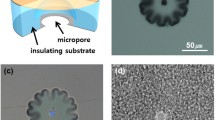Abstract
Solid-state nanopores have been gaining popularity in nano-biotechnology for single molecule detection, in particular for label-free high-throughput DNA sequencing. In order to address the improvement of the resolution/speed trade-off critical in this application, here we present a new two-channel current amplifier tailored for solid-state nanopore devices with integrated tunneling electrodes. The simultaneous detection of ion and tunneling currents provides enhanced molecule tracking capability. We describe the system design starting from a detailed noise analysis and device modeling, highlighting the detrimental role of the conductive silicon substrate and of all the stray capacitive couplings between the electrodes. Given the high input capacitance (0.1–1 nF), the input voltage noise has been carefully minimized choosing a discrete couple of matched low-noise JFETs as input stage, thus achieving an equivalent input noise of 1.5 nV/√Hz (corresponding to a current noise floor of 15 fA/√Hz at 10 kHz). Low-noise performance (11 pA rms noise integrated over a 75 kHz bandwidth) is preserved at a wide bandwidth (300 kHz) and high gain (100 MΩ) thanks to the adoption of an improved integrator/differentiator cascade topology. Furthermore, along with biasing networks and selectable low-pass filters, an AC-coupled channel providing additional gain has been introduced in order to “zoom” in the current signature during pore blockade events. Together with an experimental characterization of the system (and comparison with the noise performance of other instruments), the platform is validated by demonstrating the detection of λ-DNA with 20 nm pores.










Similar content being viewed by others
References
Martin, C. R., & Siwy, Z. S. (2007). Learning nature’s way: Biosensing with synthetic nanopores. Science, 317, 331–332.
Dekker, C. (2007). Solid-state nanopores. Nature Nanotechnology, 2, 209–215.
Zhang, B., Galusha, G., Shiozawa, P. G., Wang, G., Bergren, A. J., Johns, R. M., et al. (2007). A bench-top method for fabricating glass-sealed nanodisk electrodes, glass nanopore electrodes, and glass nanopore membranes of controlled size. Analytical Chemistry, 79, 4778–4787.
DeBlois, R. W., & Bean, C. P. (1970). Counting and sizing of submicron particles by the resistive pulse technique. Review of Scientific Instruments, 41(7), 909–915.
Fraikin, J., Teesalu, T., McKenney, C. M., Ruoslaht, E., & Cleland, A. N. (2011). A high-throughput label-free nanoparticle analyser. Nature Nanotechnology, 6, 308–313.
Venkatesan, B. M., & Bashir, R. (2011). Nanopore sensors for nucleic acid analysis. Nature Nanotechnology, 6, 615–624.
Wanunu, M. (2012). Nanopores: A journey towards DNA sequencing. Physics of Life Reviews, 9(2), 125–158.
Peng, H., & Ling, X. S. (2009). Reverse DNA translocation through a solid-state nanopore by magnetic tweezers. Nanotechnology, 20, 185101–185108.
Chen, Z., et al. (2010). DNA translocation through an array of kinked nanopores. Nature Materials, 9, 667–675.
Cherf, G. M., Lieberman, K. R., Rashid, H., Lam, C. E., Karplus, K., & Akeson, M. (2012). Automated forward and reverse ratcheting of DNA in a nanopore at 5-Å precision. Nature Biotechnology, 30, 344–348.
Albrecht, T. (2012). Electrochemical tunneling sensors and their potential application. Nature Communications, 3(829), 1–9.
Huang, S., He, J., Chang, S., Zhang, P., Liang, F., Li, S., et al. (2010). Identifying single bases in a DNA oligomer with electron tunnelling. Nature Nanotechnology, 5, 868–887.
Ivanov, A. P., Instuli, E., McGilvery, C. M., Baldwin, G., McComb, D. W., Albrecht, T., et al. (2011). DNA tunneling detector embedded in a nanopore. Nano Letters, 11, 279–285.
Smeets, R. M., Keyser, U. F., Dekker, N. H., & Dekker, C. (2008). Noise in solid-state nanopores. PNAS, 105(2), 417–421.
Dimitrov, V., Mirsaidov, U., Wang, D., Sorsch, T., Mansfield, W., Miner, J., et al. (2010). Nanopores in solid-state membranes engineered for single molecule detection. Nanotechnology, 21, 065502–065511.
Carminati, M., Vergani, M., Ferrari, G., Caranzi, L., Caironi, M., & Sampietro, M. (2012). Accuracy and resolution limits in quartz and silicon substrates with microelectrodes for electrochemical biosensors. Sensors and Actuators B, 172, 168–175.
Timp, W., Mirsaidov, U., Wang, D., Comer, J., Aksimentiev, A., & Timp, G. (2010). Nanopore sequencing: Electrical measurements of the code of life. IEEE Transactions on Nanotechnology, 9(3), 281–294.
Meller, A., Nivon, L., & Branton, D. (2001). Voltage-driven DNA translocations through a nanopore. Physical Review Letters, 86, 3435–3438.
Crescentini, M., Bennati, M., Carminati, M., & Tartagni, M. (2013). Noise limits of CMOS current interfaces for biosensors: A review. IEEE Trans. Biomedical Circuits and Systems (in press).
Carminati, M., Ferrari, G., Bianchi, D., & Sampietro, M. (2013). Femtoampere integrated current preamplifier for low noise and wide bandwidth electrochemistry with nanoelectrodes. Electrochimica Acta (in press).
Rosenstein, J. K., Wanunu, M., Merchant, C. A., Drndic, M., & Shepard, K. L. (2012). Integrated nanopore sensing platform with sub-microsecond temporal resolution. Nature Methods, 9, 487–492.
Ciofi, C., Crupi, F., Pace, C., Scandurra, G., & Patanè, M. (2007). A new circuit topology for the realization of very low-noise wide-bandwidth transimpedance amplifier. IEEE Transactions on Instrumentation and Measurement, 56(3), 1626–1631.
Vergani, M., et al. (2012). Multichannel bipotentiostat integrated with a microfluidic platform for electrochemical real-time monitoring of cell cultures. IEEE Transaction on Biomedical Circuits and Systems, 6(5), 498–507.
Ayub, M., Ivanov, A., Hong, J., Kuhn, P., Instuli, E., Edel, J. B., et al. (2010). Precise electrochemical fabrication of sub-20 nm solid-state nanopores for single-molecule biosensing. Journal of Physics, 22, 8–454128.
Ferrari, G., Farina, M., Guagliardo, F., Carminati, M., & Sampietro, M. (2009). Ultra low noise CMOS current preamplifier from DC to 1 MHz. Electronics Letters, 45, 1278–1280.
Ferrari, G., Gozzini, F., Molari, A., & Sampietro, M. (2009). Transimpedance amplifier for high sensitivity current measurements on nanodevices. IEEE Journal of Solid-State Circuits, 44, 1609–1616.
Acknowledgments
Fondazione CARIPLO and The Royal Society are gratefully acknowledged for partial financial support. Fatma Dogan and Thomas Gibb are also thanked for fruitful discussions.
Author information
Authors and Affiliations
Corresponding author
Rights and permissions
About this article
Cite this article
Carminati, M., Ferrari, G., Ivanov, A.P. et al. Design and characterization of a current sensing platform for silicon-based nanopores with integrated tunneling nanoelectrodes. Analog Integr Circ Sig Process 77, 333–343 (2013). https://doi.org/10.1007/s10470-013-0193-9
Received:
Revised:
Accepted:
Published:
Issue Date:
DOI: https://doi.org/10.1007/s10470-013-0193-9




